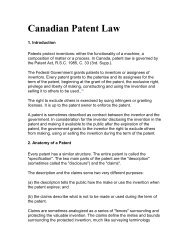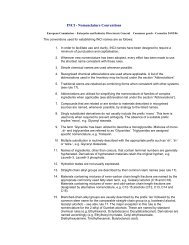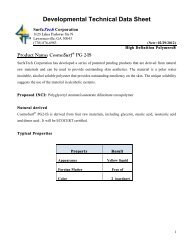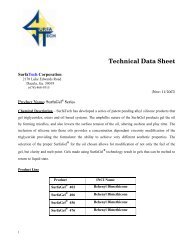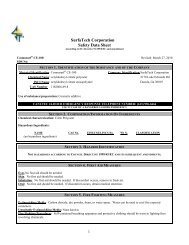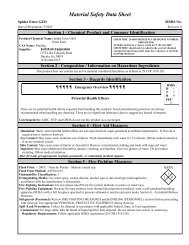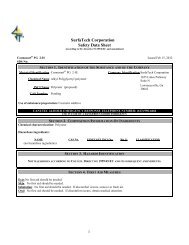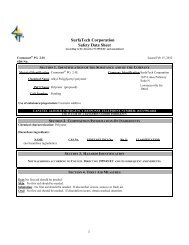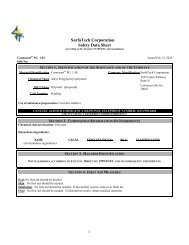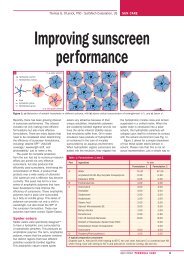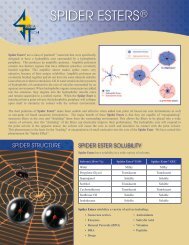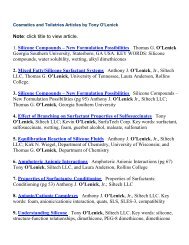Emulsions - SurfaTech
Emulsions - SurfaTech
Emulsions - SurfaTech
You also want an ePaper? Increase the reach of your titles
YUMPU automatically turns print PDFs into web optimized ePapers that Google loves.
<strong>Emulsions</strong><br />
BY<br />
Dr. Jarupa Viyoch<br />
Dept. of Pharmaceutical<br />
Technology (2106)
• Definition<br />
• Composition<br />
• Type of emulsions<br />
Determination<br />
Test<br />
Scope<br />
• Selection of ingredients<br />
• Emulsion consistency<br />
• Emulsion theory<br />
• Emulsifying agent<br />
• Preparation<br />
• HLB system<br />
• Stability
<strong>Emulsions</strong><br />
heterogenous systems of one liquid<br />
dispersed throughout another in the<br />
form of droplets usually exceeding 0.1<br />
micrometre in diameter
Compositions<br />
Internal/Discontinuous/Dispersed phase<br />
External/Continuous phase<br />
Emulsifying agent<br />
Forms<br />
Liquids<br />
Semisolids
Emulsion Types<br />
1. oil-in-water (o/w)<br />
2. water-in-oil (w/o)<br />
3. water-in-oil-in-water (w/o/w)<br />
4. oil-in-water-in-oil (o/w/o)
Determination of<br />
Emulsion Types<br />
• By phase ratio between oil and water<br />
phase<br />
• By order of addition<br />
slowly add oil into water o/w<br />
• By type of emulsifier<br />
phase that the emulsifier is soluble will<br />
most probably be continuous phase
Tests for Identification of<br />
Emulsion Types<br />
• Dilution test:<br />
emulsion can be diluted only with external<br />
phase<br />
• Dye test:<br />
• CoCl 2/filter paper test:<br />
filter paper impregnated with CoCl 2 and dried<br />
(blue) changes to pink when o/w emulsion is<br />
added<br />
• Fluorescence:<br />
oils fluoresce under UV light<br />
• Conductivity: for ionic o/w emulsions<br />
o/w emulsions conduct electric current
Choice of Emulsion Types<br />
• Fats or oils for oral administration:<br />
- o/w is formed to mask unpleasant taste<br />
• For i.v. administration:<br />
- o/w<br />
- w/o<br />
• For external application:<br />
- o/w<br />
for water soluble drugs<br />
easily wash from skin<br />
non greasy texture
- w/o<br />
occlusive effect influence the<br />
absorption of drugs<br />
cleansing skin<br />
moisturizing creams (designed to<br />
prevent moisture loss from skin)
Choice of Oil Phase<br />
• The type of oil affect on:<br />
- viscosity<br />
- spread<br />
- film forming<br />
- the transport of drug into skin<br />
• i.e. liquid paraffin (hard, soft and light<br />
liquid paraffin), silicone, beeswax, fatty<br />
alcohol and so on
Emulsion Consistency<br />
Texture or feel of a product<br />
- viscosity<br />
Rheological properties of emulsion can be<br />
controlled by:<br />
1. Volume concentration of dispersed phase:<br />
if increase viscosity of<br />
product increase<br />
if above about 60% phase<br />
inversion
2. Particle size of disperse phase:<br />
decrease size increase viscosity<br />
small globule increase flocculation<br />
polydispersed system lower viscosity<br />
3. Viscosity of continuous phase<br />
4. Nature and concentration of emulsifying<br />
system
Purpose of <strong>Emulsions</strong><br />
Oral formulation<br />
1. Enhancing bioavailability<br />
2. Giving controlled rate of drug release<br />
3. Affording protection to oxidation or<br />
hydrolysis<br />
Topical formulation<br />
1. Easily applied and can be formulated to<br />
eliminate oiliness and staining<br />
2. Carrying water which is an excellent<br />
softener to skin
Emulsion Theory<br />
• To explain how emulsifying agents act in<br />
promoting emulsification and in maintaining the<br />
stability of the resulting emulsion<br />
- Surface tension theory (important in initial formation)<br />
The force causing each liquid to resist<br />
breaking up into smaller particle is called<br />
interfacial tension. Surfactants promote the<br />
lowering of this resistance<br />
- Surface orientation theory<br />
Emulsifying agent having a greater<br />
hydrophilic character than hydrophobic<br />
character will promote an o/w emulsion
- Plastic or interfacial film theory<br />
emulsifying agent surrounding the<br />
droplets of the internal phase as a thin<br />
layer of film adsorbed on the surface of<br />
the droplets, prevent the contact and<br />
coalescing of the internal phase<br />
- Rate of coalescence theory<br />
- Phase volume theory
• Monomolecular film<br />
• Multimolecular film<br />
• Solid particle film<br />
oil<br />
Film<br />
Water<br />
Solid<br />
? E = ? 2 ? o/w (1- cos ?)<br />
? E = the energy to expel an absorbed particle from the<br />
interface into the phase that it is predominant wet<br />
? = its contact angle between solid and water phase
oil oil<br />
solid<br />
90 90<br />
interface<br />
most stable<br />
γ s/w < ? s/o<br />
o/w<br />
γ s/w > ? s/o<br />
w/o<br />
water
Mechanism<br />
• To form droplets<br />
- surface free energy or surface tension<br />
- system at its lowest free energy is<br />
thermodynamically stable<br />
- emulsions are not thermodynamically stable<br />
• To stabilize droplets (by surfactants or<br />
polymers)<br />
- by reducing the interfacial tension<br />
- by packing of the emulsifier molecules
Microemulsions<br />
• The droplet size is below 0.15 micrometer<br />
• Transparent<br />
• Form spontaneously during preparation<br />
• Thermodynamically stable (no change<br />
spontaneously, and if forced to change, it<br />
will return to the stable state)
Emulsifying agents<br />
• must be present at the interface to prevent<br />
coalescence of the internal phase:<br />
1. To reduce the interfacial tension<br />
2. To be interfacial barrier (most influence on<br />
emulsion stability)<br />
- increase viscosity of continuous phase<br />
- energy barrier<br />
the electric double layer<br />
--<br />
+ - -<br />
+<br />
-<br />
+<br />
+ - -<br />
+<br />
+<br />
the steric repulsion from absorbed polymer<br />
+<br />
+<br />
+<br />
tail<br />
loop<br />
train
Compositions<br />
Emulsifying agents, Emulsifiers, Emulgents,<br />
Surfactants<br />
- primary<br />
- auxiliary<br />
The other formulation additives<br />
1. Preservatives: MP:PP 10:1<br />
2. Antioxidants: BHT, BHA etc.<br />
3. Humectants: propylene glycol, glycerol,<br />
sorbitol
Fact of Emulsifying Agents<br />
• Structure<br />
hydrocarbon<br />
• Reside at interface<br />
polar group<br />
• When the concentration is increased in<br />
excess of CMC (the critical micellization<br />
concentration), micelles is formed
Properties<br />
1. Compatible with the other ingredients<br />
2. Not interfere with the stability or<br />
efficacy of the therapeutic agent<br />
3. Stable and not deteriorate in the<br />
preparation<br />
4. Nontoxic<br />
5. Little odor, taste or color<br />
6. Promote emulsification and to maintain the<br />
stability
Emulsifier Classification<br />
According to ionic composed of an organic<br />
lipophilic group (surface active portion)<br />
• Synthetic and semisynthetic surfactants<br />
- Anionic<br />
- Cationic<br />
- Nonionic<br />
- Amphoteric<br />
• Naturally occurring materials and their<br />
derivativrs
Anionic Surfactants<br />
• Soaps<br />
Fatty acid + Base Soaps<br />
- o/w emulsions<br />
- in acidic condition precipitated<br />
FFA<br />
- external use<br />
- combination of soap (TEA stearate) with<br />
an oil-soluble auxiliary emulsifier (cetyl<br />
alcohol) o/w mixed emulsifer<br />
- incompatible with polyvalent cations
Anionic Surfactants (cont.)<br />
- Soap of di/trivalent metal<br />
Cal oleate w/o emulsions<br />
- Amine soaps: N(CH 2CH 2OH) 3<br />
neutral pH<br />
incompatible with acids and high<br />
concentration of electrolytes<br />
• Sulfated and sulfonated compound:<br />
- SLS<br />
stable over high pH range<br />
o/w emulsions
• Sulfated and sulfonated compound (cont.)<br />
- SLS<br />
fairly resistant to divalent metal ions<br />
used in combination with a nonionic<br />
oil-soluble emulsifying agent or fatty<br />
alcohol to produce a good emulsions<br />
- sodium dioctylsulfosuccinate<br />
used as wetting agent
Cationic surfactants<br />
• Quaternary ammonium compounds:<br />
Cetyl trimethylammonium bromide<br />
(Cetrimide) CH 3(CH 2) 15N + (CH 3) 3Br -<br />
• Used with nonionic, oil-soluble auxiliary<br />
emulsifiers<br />
• Toxicity and irritancy<br />
• Incompatible with anionic surfactants,<br />
polyvalent anions and unstable at high pH
Nonionic surfactants<br />
• Low toxicity and irritancy oral,<br />
parenteral<br />
• High degree of compatibility<br />
• Less sensitive to change pH or to addition<br />
of electrolytes<br />
• Most of them are based on:<br />
1. Hydrophobic part: FA or alcohol (C 12-18)<br />
2. Hydrophilic part: alcohol (-OH) and/or<br />
ethylene oxide (-OCH 2CH 2)
Nonionic surfactants (cont.)<br />
• Glycol and glycerol esters<br />
- Glyceryl monostearate (a polyhydric alcohol<br />
FA ester):<br />
strongly hydrophobic material<br />
produce w/o emulsions<br />
- Self-emulsifying glycerol monostearate<br />
soap + glyceryl monooleate<br />
diethylene glycol monostearate<br />
propylene glycol monooleate
Nonionic surfactants (cont.)<br />
• Sorbitan esters<br />
- the esterification of 1 or more of<br />
the hydroxyl groups of sorbitan with<br />
either lauric, oleic, palmitic or steraic<br />
acid<br />
- tend to form w/o<br />
- used with polysorbates to produce<br />
o/w or w/o
Nonionic surfactants (cont.)<br />
• Polysorbates (Tween)<br />
- polyethylene glycol derivatives of the<br />
sorbitan ester<br />
- variation in water solubility based on:<br />
type of FA<br />
the number of oxyethylene gr. in the<br />
polyethylene glycol chains<br />
- compatible with most anionic, cationic and<br />
nonionic materials
• Polysorbates (cont.)<br />
- provide neutral pH and stable to the<br />
effects of heat, pH change and high<br />
conc. of electrolytes<br />
- low toxicity<br />
- unpleasant taste<br />
- form complex with preservatives
• Fatty alcohol polyglycol ethers<br />
- condensation products of polyethylene glycol<br />
and fatty alcohols: polyethylene glycol<br />
monocetyl ether (Cetomacrogol 1000)<br />
- high water solubility<br />
- stable over a wide pH range<br />
- salted out by high conc. of electrolytes<br />
- o/w emulsions (should used with oil-soluble<br />
auxiliary emulsifier: Cetostearyl alcohol
• Fatty acid polyglycol esters<br />
- stearate esters or polyoxyl stearates<br />
- i.e. polyoxyethylene 40 stearate (40 = the no.<br />
of oxyethylene units)<br />
water-soluble<br />
used with stearyl alcohol to give o/w<br />
• Poloxalkols<br />
- polyoxyethylene/polyoxypropylene<br />
copolymers<br />
- used for i.v. fat emulsions
• Higher fatty alcohol<br />
- saturated aliphatic monohydeic alcohols:<br />
hexadecl (cetyl), octadecyl (stearyl)<br />
- used as auxiliary emulsifiers according to<br />
their ability to increase viscosity<br />
- i.e.<br />
cetostearyl alcohol + SLS/ o/w<br />
Cetrimide/<br />
Cetomacrogol 1000
Amphoteric surfactants<br />
• charge depending on the pH of the<br />
system<br />
low pH cationic<br />
high pH anionic<br />
• i.e. lecithin: used to stabilize i.v. fat<br />
emulsion
Naturally Occurring Materials<br />
and Their Derivatives<br />
Disadvantage<br />
- batch to batch variation<br />
- susceptible to bacterial and mold growth<br />
- susceptible to alcohol, electrolytes<br />
• Polysaccharides<br />
- i.e. acacia, tragacanth, sodium alginate<br />
anionic<br />
stabilize o/w (internal)<br />
forming a strong multimolecular film<br />
(hydrophilic barrier) round oil globule
• Semisynthetic polysaccharides<br />
- to reduce batch to batch variation<br />
- as o/w emulsifiers or stabilizer<br />
- i.e. MC (nonionic), CMC (anionic)<br />
• Sterol-containing substance<br />
- Beeswax: beeswax-borax<br />
- Wool fat (anhydrous lanolin)<br />
fatty alcohol with FA esters of cholesterol<br />
and other sterols<br />
form w/o<br />
emollient property<br />
water absorbing property<br />
odor: require antioxidant
• Sterol-containing substance (cont.)<br />
- polyoxyethylene lanolin derivatives<br />
water soluble<br />
o/w emulsifier<br />
emollient property<br />
- wool alcohol<br />
cholesterol together with other alcohols<br />
w/o emulsifier<br />
no strong odor (but still require<br />
antioxidant)<br />
- Protein substances<br />
i.e. gelatin, egg yolk and casein<br />
o/w emulsifier<br />
gelatin; provide emulsion that is too fluid
Finely Divided Solids<br />
• i.e. bentonite, aluminium magnesium<br />
silicate, colloidal silicon dioxide<br />
- forming a coherent film which physical<br />
prevents coalescence of the dispersed<br />
globules<br />
- if the particles are:<br />
preferntially wetted by the aqueous<br />
phase o/w emulsion<br />
preferntially wetted by the oil phase<br />
w/o emulsion
Preparation<br />
• Method depending on:<br />
- the nature of emulsion components<br />
- the equipment available<br />
porcelain mortar and pestle<br />
bottle<br />
homogenizer/ hand homoginizer<br />
colloid mill
Continental or dry gum<br />
method<br />
• 4:2:1 oil:water:gum primary<br />
emulsion<br />
• Emulsifier is triturated with the oil in perfectly<br />
dry porcelain mortar<br />
2 parts of water are added at once<br />
triturate immediately, rapidly and<br />
continuously (until get a cracking sound)<br />
aqueous solution is added (alcohol the last, if any)
land oil should be added if oil is less than 20%<br />
Prepare 50 ml (4:2:1)<br />
Rx Calciferol solution 0.15 ml<br />
Glycerin 0.30 ml<br />
Water to 5.00 ml<br />
Rx Calciferol solution 1.5 ml<br />
Arachis oil 8.5 ml<br />
Water 5.0 ml<br />
Acacia powder<br />
primary emulsion<br />
2.5 ml
English or Wet Gum Method<br />
triturate gum with twice its weight<br />
of water in a mortar<br />
oil is added slowly in portions<br />
the mixture is triturated<br />
after adding all of the oil, thoroughly<br />
mixed for several minute<br />
Caution: the mixture become too thick (ropy)<br />
during the process, additional water may<br />
be blended
Bottle or Forbes Bottle<br />
Method<br />
• Extemporaneous preparation for volatile<br />
oils or oil with low viscosity<br />
gum + 2 parts of oil (dry bottle)<br />
shake<br />
water (volume equal to oil)<br />
is added in portions<br />
shake
Beaker Method<br />
Oil phase: heated about 5-10 degree above the<br />
highest melting point of ingredient (water bath)<br />
Water phase: heated to the same temperature of<br />
oil phase (water bath)<br />
Add: internal phase into external phase, mix,<br />
constant agitation being provided throughout<br />
the time of addition<br />
Caution: - not to heat the phase above 85 degree<br />
- rate of cooling determining the final<br />
texture and consistancy



